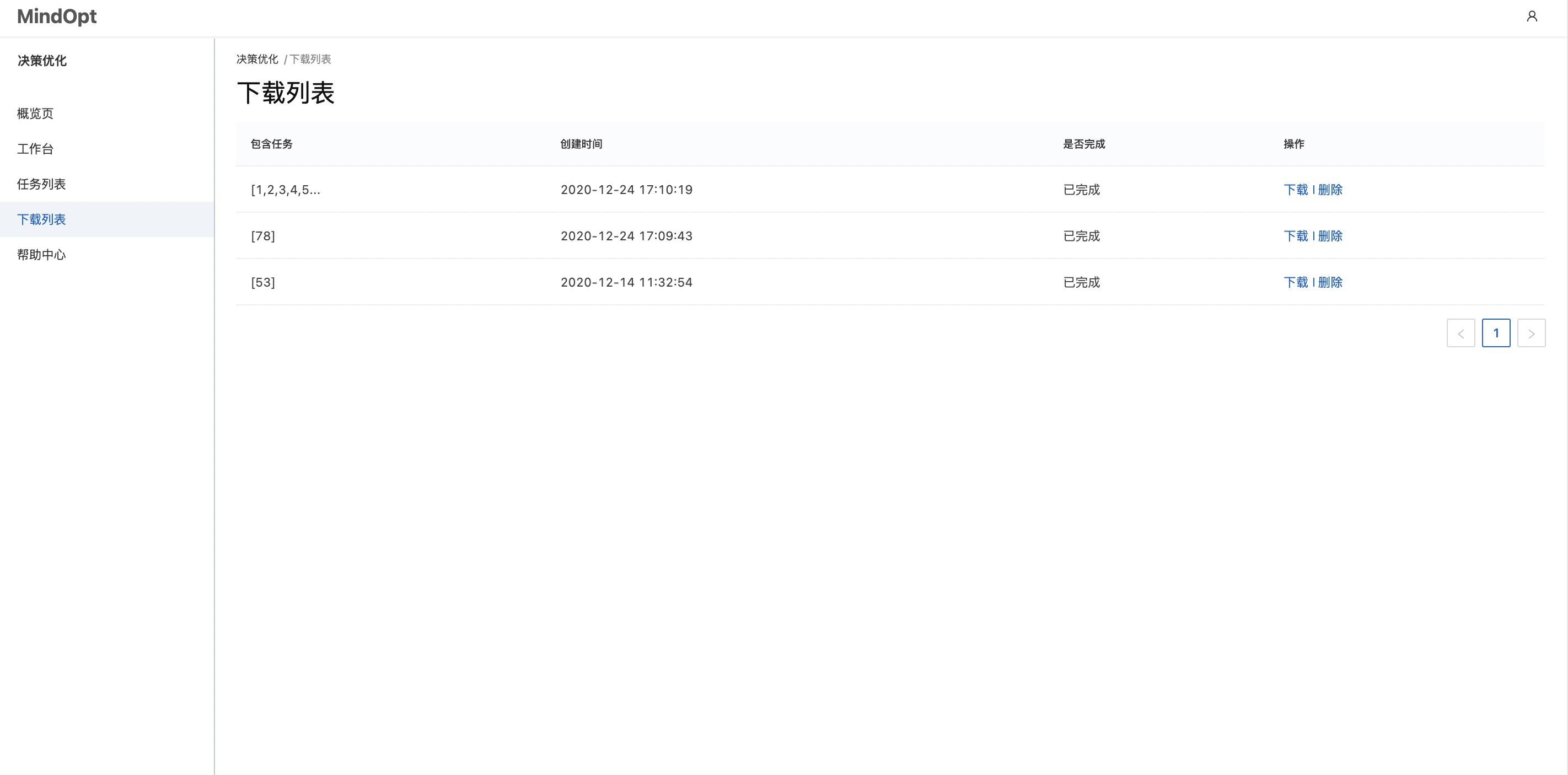这一部分将介绍如何在客户端程序中调用远程计算服务并在 Web 页面中查看结果。
7.4. Client-Server 接口调用方式¶
当我们使用 MindOpt 的远程计算服务时,优化求解的执行过程被分作客户端建模和计算服务器求解两个部分,它们之间的通信则依靠 API 来执行。 用户可以使用标准的 MindOpt API(C/C++/Python,后续会支持更多语言接口)来构建优化模型和设置相关的算法参数,然后提交给 Server 来进行求解。
Server 成功接收作业请求后,将返回一个唯一的作业 ID job_id。
用户可以再通过这个 job_id 去查询和监控优化模型求解的状态(Submitted、Solving、Failed、Finished)。一旦该作业被处理完(状态为 Finished 或 Failed),客户端就可以向 Server 获取结果。
通过客户端提交任务和获取结果主要用到以下两类接口:
上传模型: 用于向服务器提交作业并获取返回的作业 ID。
获取结果: 用于通过作业 ID 向服务器检索状态并下载计算结果。
接口 |
C 语言 |
C++ 语言 |
Python 语言 |
上传模型 |
|
||
获取结果 |
|
其中,在上传模型时,需要将模型和参数的序列化文件上传至远程服务器进行求解;在获取结果时,也需要对序列化的模型和参数进行加载。为了适应用户对不同使用场景的需求,在设置序列化文件的存取时主要有两种实现方式。
第一种方式,用户可以自定义保存的文件和参数名,以 C 语言为例,使用 model_file 和 param_file 来分别指定序列化模型和参数文件的存储文件名(若文件名中包含路径,则需要保证路径存在且具有写入权限,否则会报错)。
然后在优化程序中指定求解器将这两个文件写入指定位置。
Mdo_writeTask(model, model_file, MDO_YES, MDO_NO, MDO_NO);
Mdo_writeTask(model, param_file, MDO_NO, MDO_YES, MDO_NO);
并进行参数设置,让求解器将对应的文件上传至远程服务器进行求解。
Mdo_setStrParam(model, "Remote/File/Model", model_file);
Mdo_setStrParam(model, "Remote/File/Param", param_file);
在获取结果阶段,若模型为空,则需要通过以下方式加载序列化模型和参数。
Mdo_readTask(model, model_file, MDO_YES, MDO_NO, MDO_NO);
Mdo_readTask(model, param_file, MDO_NO, MDO_YES, MDO_NO);
此外,由于在获取结果时,需要将远程服务器回传的计算结进行保存,因此还需要指定序列化解文件的存储路径(若文件名中包含路径,则需要保证路径存在且有写入权限,否则会报错)。并指定参数 "Remote/File/Model" 和 "Remote/File/Param",进行序列化文件的读取。
const char * soln_file = "./my_soln.mdo";
Mdo_setStrParam(model, "Remote/File/Soln", soln_file);
Mdo_setStrParam(model, "Remote/File/Model", model_file);
Mdo_setStrParam(model, "Remote/File/Param", param_file);
第二种方式,用户只需指定将要保存的文件的文件夹路径,例如 filepath (需要保证路径存在且有写入权限)。然后直接在参数设置时指定 "Remote/File/Path",求解器会自动执行写入序列化文件的过程。
const char * filepath = "./tmp";
Mdo_setStrParam(model, "Remote/File/Path", filepath);
类似的,在获取结果阶段,进行该参数设置后求解器会利用 filepath 和 job_id 到相应路径寻找序列化文件并加载到模型和参数中。例如,若 job_id 为 10,则序列化模型、参数、解文件的文件名分别为 m10.mdo、p10.mdo 和 s10.mdo。
我们所有的 API 都建立在 C API 的基础上。C API 会负责构建内部数据结构、调用 MindOpt 中的优化算法以及生成解的相关信息等。 在本地机器上运行 MindOpt 时,C API 将在本地内存中构建相关的数据结构。 在计算服务器中,MindOpt C API 会在接收到模型和参数数据后,将其作为优化算法的输入,并生成解的数据作为输出。
下面我们将通过具体的示例代码展示如何在不同的客户端 SDK (C/C++/Python) 中通过 API 来使用远程计算服务。
7.5. 客户端 C 程序示例¶
我们通过如下的 C 程序展示如何调用 Mdo_submitTask 和 Mdo_retrieveTask API 进行作业上传和获取结果。
7.5.1. 上传模型¶
7.5.1.1. 从 MPS 文件读取模型上传¶
这个部分的程序展示了读取 MPS 文件、设置算法配置参数、序列化模型和参数、提交作业任务的过程,如果任务提交成功,最终我们会拿到服务端返回的 job_id,我们用它来查询作业状态。
Note
需提供准备好的 MPS 文件和算法配置参数以及 Server 端 Token(需要获取自己的 Token)等必要信息。
1/**
2 * Description
3 * -----------
4 *
5 * Input model, specify parameters, serialize all the inputs, and then upload these data onto server.
6 */
7#include <stdio.h>
8#include "Mindopt.h"
9
10/* Macro to check the return code */
11#define MDO_CHECK_CALL(MDO_CALL) \
12 code = MDO_CALL; \
13 if (code != MDO_OKAY) \
14 { \
15 Mdo_explainResult(model, code, str); \
16 Mdo_freeMdl(&model); \
17 fprintf(stderr, "===================================\n"); \
18 fprintf(stderr, "Error : code <%d>\n", code); \
19 fprintf(stderr, "Reason : %s\n", str); \
20 fprintf(stderr, "===================================\n"); \
21 return (int)code; \
22 }
23
24int main(
25 int argc,
26 char * argv[])
27{
28 /* Variables. */
29 char str[1024] = { "\0" };
30 /* Input mps file (optimization problem) */
31 const char * input_file = "./afiro.mps";
32 /* Output serialized files */
33 const char * model_file = "./my_model.mdo";
34 const char * param_file = "./my_param.mdo";
35 MdoResult code = MDO_OKAY;
36 MdoMdl * model = NULL;
37 char job_id[1024]= { "\0" };
38
39 /*------------------------------------------------------------------*/
40 /* Step 1. Create a model and change the parameters. */
41 /*------------------------------------------------------------------*/
42 /* Create an empty model. */
43 MDO_CHECK_CALL(Mdo_createMdl(&model));
44
45 /*------------------------------------------------------------------*/
46 /* Step 2. Input model and parameters. */
47 /*------------------------------------------------------------------*/
48 /* Read model from file. */
49 MDO_CHECK_CALL(Mdo_readProb(model, input_file));
50
51 /* Input parameters. */
52 Mdo_setIntParam(model, "NumThreads", 4);
53 Mdo_setRealParam(model, "MaxTime", 3600);
54
55 /*------------------------------------------------------------------*/
56 /* Step 3. Serialize the model and the parameters. */
57 /*------------------------------------------------------------------*/
58 MDO_CHECK_CALL(Mdo_writeTask(model, model_file, MDO_YES, MDO_NO, MDO_NO));
59 MDO_CHECK_CALL(Mdo_writeTask(model, param_file, MDO_NO, MDO_YES, MDO_NO));
60
61 /*------------------------------------------------------------------*/
62 /* Step 4. Input parameters related to remote computing. */
63 /*------------------------------------------------------------------*/
64 /* Input parameters related to remote computing. */
65 Mdo_setStrParam(model, "Remote/Token", "xxxxxxxxxtokenxxxxxxxx"); // Change to your token
66 Mdo_setStrParam(model, "Remote/Desc", "my model");
67 Mdo_setStrParam(model, "Remote/Server", "127.0.0.1"); // Change to your server IP
68 Mdo_setStrParam(model, "Remote/File/Model", model_file);
69 Mdo_setStrParam(model, "Remote/File/Param", param_file);
70
71 /*------------------------------------------------------------------*/
72 /* Step 5. Upload serialize model and parameter to server, and */
73 /* then optimize the model. */
74 /*------------------------------------------------------------------*/
75 MDO_CHECK_CALL(Mdo_submitTask(model, job_id));
76 if (job_id[0] == '\0')
77 {
78 printf("ERROR: Invalid job ID: %s\n", job_id);
79 }
80 else
81 {
82 printf("Job was submitted to server successfully.\n");
83 printf("User may query the optimization result with the following job ID: %s\n", job_id);
84 }
85
86 /*------------------------------------------------------------------*/
87 /* Step 6. Free the model. */
88 /*------------------------------------------------------------------*/
89 /* Free the model. */
90 Mdo_freeMdl(&model);
91
92 return (int)code;
93}
7.5.1.2. 自定义优化模型上传¶
这个部分的程序展示了自定义优化模型、设置算法配置参数、序列化模型和参数、提交作业任务的过程,如果任务提交成功,最终我们会拿到服务端返回的 job_id,我们将用它来查询作业的状态。
Note
需提供准备好的 MPS 文件和算法配置参数以及 Server 端 Token(需要获取自己的 Token)等必要信息。
1/**
2 * Description
3 * -----------
4 *
5 * Input model, specify parameters, serialize all the inputs, and then upload these data onto server.
6 */
7#include <stdio.h>
8#include "Mindopt.h"
9
10/* Macro to check the return code */
11#define MDO_CHECK_CALL(MDO_CALL) \
12 code = MDO_CALL; \
13 if (code != MDO_OKAY) \
14 { \
15 Mdo_explainResult(model, code, str); \
16 Mdo_freeMdl(&model); \
17 fprintf(stderr, "===================================\n"); \
18 fprintf(stderr, "Error : code <%d>\n", code); \
19 fprintf(stderr, "Reason : %s\n", str); \
20 fprintf(stderr, "===================================\n"); \
21 return (int)code; \
22 }
23
24int main(
25 int argc,
26 char * argv[])
27{
28 /* Variables. */
29 char str[1024] = { "\0" };
30 const char * model_file = "./my_model.mdo";
31 const char * param_file = "./my_param.mdo";
32 MdoResult code = MDO_OKAY;
33 MdoMdl * model = NULL;
34 char job_id[1024]= { "\0" };
35
36 const int row1_idx[] = { 0, 1, 2, 3 };
37 const double row1_val[] = { 1.0, 1.0, 2.0, 3.0 };
38 const int row2_idx[] = { 0, 2, 3 };
39 const double row2_val[] = { 1.0, -1.0, 6.0 };
40
41 /*------------------------------------------------------------------*/
42 /* Step 1. Create a model and change the parameters. */
43 /*------------------------------------------------------------------*/
44 /* Create an empty model. */
45 MDO_CHECK_CALL(Mdo_createMdl(&model));
46
47 /*------------------------------------------------------------------*/
48 /* Step 2. Input model and parameters. */
49 /*------------------------------------------------------------------*/
50 /* Change to minimization problem. */
51 Mdo_setIntAttr(model, "MinSense", MDO_YES);
52
53 /* Add variables. */
54 MDO_CHECK_CALL(Mdo_addCol(model, 0.0, 10.0, 1.0, 0, NULL, NULL, "x0", MDO_NO));
55 MDO_CHECK_CALL(Mdo_addCol(model, 0.0, MDO_INFINITY, 1.0, 0, NULL, NULL, "x1", MDO_NO));
56 MDO_CHECK_CALL(Mdo_addCol(model, 0.0, MDO_INFINITY, 1.0, 0, NULL, NULL, "x2", MDO_NO));
57 MDO_CHECK_CALL(Mdo_addCol(model, 0.0, MDO_INFINITY, 1.0, 0, NULL, NULL, "x3", MDO_NO));
58
59 /* Add constraints.
60 * Note that the nonzero elements are inputted in a row-wise order here.
61 */
62 MDO_CHECK_CALL(Mdo_addRow(model, 1.0, MDO_INFINITY, 4, row1_idx, row1_val, "c0"));
63 MDO_CHECK_CALL(Mdo_addRow(model, 1.0, 1.0, 3, row2_idx, row2_val, "c1"));
64
65 /* Input parameters. */
66 Mdo_setIntParam(model, "NumThreads", 4);
67 Mdo_setRealParam(model, "MaxTime", 3600);
68
69 /*------------------------------------------------------------------*/
70 /* Step 3. Serialize the model and the parameters for later use. */
71 /*------------------------------------------------------------------*/
72 MDO_CHECK_CALL(Mdo_writeTask(model, model_file, MDO_YES, MDO_NO, MDO_NO));
73 MDO_CHECK_CALL(Mdo_writeTask(model, param_file, MDO_NO, MDO_YES, MDO_NO));
74
75 /*------------------------------------------------------------------*/
76 /* Step 4. Input parameters related to the remote computing server. */
77 /*------------------------------------------------------------------*/
78 /* Input parameters related to remote computing. */
79 Mdo_setStrParam(model, "Remote/Token", "xxxxxxxxxtokenxxxxxxxx"); // Change to your token
80 Mdo_setStrParam(model, "Remote/Desc", "my model");
81 Mdo_setStrParam(model, "Remote/Server", "127.0.0.1"); // Change to your server IP
82 Mdo_setStrParam(model, "Remote/File/Model", model_file);
83 Mdo_setStrParam(model, "Remote/File/Param", param_file);
84
85 /*------------------------------------------------------------------*/
86 /* Step 5. Upload the serialized model and parameters to server, and*/
87 /* then optimize the model. */
88 /*------------------------------------------------------------------*/
89 MDO_CHECK_CALL(Mdo_submitTask(model, job_id));
90 if (job_id[0] == '\0')
91 {
92 printf("ERROR: Invalid job ID: %s\n", job_id);
93 }
94 else
95 {
96 printf("Job was submitted to server successfully.\n");
97 printf("User may query the optimization result with the following job ID: %s\n", job_id);
98 }
99
100 /*------------------------------------------------------------------*/
101 /* Step 6. Free the model. */
102 /*------------------------------------------------------------------*/
103 /* Free the model. */
104 Mdo_freeMdl(&model);
105
106 return (int)code;
107}
7.5.2. 获取结果¶
在计算任务提交之后,可以通过如下示例程序对运行结果进行检索以及下载问题的解,该段程序将展示反序列化模型和参数、查询解状态、获取解、打印结果的过程。
Note
需提供准备好Server 端 token 和 job_id 等必要信息。
1/**
2 * Description
3 * -----------
4 *
5 * Check the solution status, download the solution, and populate the result.
6 */
7#include <stdio.h>
8#if defined(__APPLE__) || defined(__linux__)
9# include <unistd.h>
10# define SLEEP_10_SEC sleep(10)
11#else
12# include <windows.h>
13# define SLEEP_10_SEC Sleep(10000)
14#endif
15#include "Mindopt.h"
16
17/* Macro to check the return code */
18#define MDO_CHECK_CALL(MDO_CALL) \
19 code = MDO_CALL; \
20 if (code != MDO_OKAY) \
21 { \
22 Mdo_explainResult(model, code, str); \
23 Mdo_freeMdl(&model); \
24 fprintf(stderr, "===================================\n"); \
25 fprintf(stderr, "Error : code <%d>\n", code); \
26 fprintf(stderr, "Reason : %s\n", str); \
27 fprintf(stderr, "===================================\n"); \
28 return (int)code; \
29 }
30
31int main(
32 int argc,
33 char * argv[])
34{
35 /* Variables. */
36 char str[1024] = { "\0" };
37 char status[1024] = { "\0" };
38 /* Serialized files, must be the same in the submission code */
39 const char * model_file = "./my_model.mdo";
40 const char * param_file = "./my_param.mdo";
41 /* Output solution file */
42 const char * soln_file = "./my_soln.mdo";
43 const char * sol_file = "./my_soln.sol";
44 MdoResult code = MDO_OKAY;
45 MdoStatus model_status = MDO_UNKNOWN;
46 char model_status_details[1024] = { "\0" };
47 MdoResult result = MDO_OKAY;
48 char result_details[1024] = { "\0" };
49 MdoBool has_soln = MDO_NO;
50 MdoMdl * model = NULL;
51 char job_id[1024] = { "\0" };
52 double val = 0.0;
53
54 /*------------------------------------------------------------------*/
55 /* Step 1. Create a model and change the parameters. */
56 /*------------------------------------------------------------------*/
57 /* Create an empty model. */
58 MDO_CHECK_CALL(Mdo_createMdl(&model));
59
60 /*------------------------------------------------------------------*/
61 /* Step 2. Read the serialized model and parameters -- this is */
62 /* required while populating the optimization result. */
63 /*------------------------------------------------------------------*/
64 MDO_CHECK_CALL(Mdo_readTask(model, model_file, MDO_YES, MDO_NO, MDO_NO));
65 MDO_CHECK_CALL(Mdo_readTask(model, param_file, MDO_NO, MDO_YES, MDO_NO));
66
67 /*------------------------------------------------------------------*/
68 /* Step 3. Input parameters related to the remote computing server. */
69 /*------------------------------------------------------------------*/
70 Mdo_setStrParam(model, "Remote/Token", "xxxxxxxxxtokenxxxxxxxx"); // Change to your token
71 Mdo_setStrParam(model, "Remote/Server", "127.0.0.1"); // Change to your server IP
72 Mdo_setStrParam(model, "Remote/File/Model", model_file);
73 Mdo_setStrParam(model, "Remote/File/Param", param_file);
74 Mdo_setStrParam(model, "Remote/File/Soln", soln_file);
75 strcpy(job_id, "1"); // Change to the jobID you received after submit the task
76
77 /*------------------------------------------------------------------*/
78 /* Step 4. Check the solution status periodically, and */
79 /* download the its upon availability. */
80 /*------------------------------------------------------------------*/
81 do
82 {
83 MDO_CHECK_CALL(Mdo_retrieveTask(model, job_id, status, &model_status, &result, &has_soln));
84
85 /* Sleep for 10 seconds. */
86 SLEEP_10_SEC;
87 }
88 while (status[0] == 'S'); /* Continue the loop if the status is in either Submitted status or Solving status. */
89
90 /*------------------------------------------------------------------*/
91 /* Step 5. Un-serialize the solution and then populate the result. */
92 /*------------------------------------------------------------------*/
93 printf("\nPopulating optimization results.\n");
94 Mdo_explainStatus(model, model_status, model_status_details);
95 Mdo_explainResult(model, result, result_details);
96
97 printf(" - Job status : %s\n", status);
98 printf(" - Model status : %s (%d)\n", model_status_details, model_status);
99 printf(" - Optimization status : %s (%d)\n", result_details, result);
100 printf(" - Solution availability : %s\n", has_soln ? "available" : "not available");
101 if (has_soln)
102 {
103 printf("\nPopulating solution.\n");
104 MDO_CHECK_CALL(Mdo_readTask(model, soln_file, MDO_NO, MDO_NO, MDO_YES));
105 Mdo_displayResults(model);
106 Mdo_writeSoln(model, sol_file);
107
108 Mdo_getRealAttr(model, "PrimalObjVal", &val);
109 printf(" - Primal objective value : %e\n", val);
110 Mdo_getRealAttr(model, "DualObjVal", &val);
111 printf(" - Dual objective value : %e\n", val);
112 Mdo_getRealAttr(model, "SolutionTime", &val);
113 printf(" - Solution time : %e sec.\n", val);
114 }
115
116 /*------------------------------------------------------------------*/
117 /* Step 6. Free the model. */
118 /*------------------------------------------------------------------*/
119 /* Free the model. */
120 Mdo_freeMdl(&model);
121
122 return (int)code;
123}
7.6. 客户端 C++ 程序示例¶
我们通过如下 C++ 程序展示如何调用 submitTask 和 retrieveTask API 进行作业上传和获取结果。
7.6.1. 上传模型¶
7.6.1.1. 从 MPS 文件读取模型上传¶
这个部分的程序展示了读取 MPS 文件、设置算法配置参数、序列化模型和参数、提交作业任务的过程,如果任务提交成功,最终我们会拿到服务端返回的 job_id,我们用它来查询作业的状态。
Note
需提供准备好的 MPS 文件和算法配置参数以及 Server 端 Token(需要获取自己的 Token)等必要信息。
1/**
2 * Description
3 * -----------
4 *
5 * Input model, specify parameters, serialize all the inputs, and then upload these data onto server.
6 */
7#include <iostream>
8#include <vector>
9#include "MindoptCpp.h"
10
11using namespace mindopt;
12
13int main(
14 int argc,
15 char * argv[])
16{
17 /* Variables. */
18 /* Input mps file (optimization problem) */
19 std::string input_file("./afiro.mps");
20 /* Output serialized files */
21 std::string model_file("./my_model.mdo");
22 std::string param_file("./my_param.mdo");
23 std::string job_id;
24
25 /*------------------------------------------------------------------*/
26 /* Step 1. Create a model and change the parameters. */
27 /*------------------------------------------------------------------*/
28 /* Create an empty model. */
29 MdoModel model;
30 /* Read model from mps file */
31 model.readProb(input_file);
32
33
34 try
35 {
36 /*------------------------------------------------------------------*/
37 /* Step 2. Input model and parameters. */
38 /*------------------------------------------------------------------*/
39 /* Input parameters. */
40 model.setIntParam("NumThreads", 4);
41 model.setRealParam("MaxTime", 3600);
42
43 /*------------------------------------------------------------------*/
44 /* Step 3. Serialize the model and the parameters. */
45 /*------------------------------------------------------------------*/
46 model.writeTask(model_file, MDO_YES, MDO_NO, MDO_NO);
47 model.writeTask(param_file, MDO_NO, MDO_YES, MDO_NO);
48
49 /*------------------------------------------------------------------*/
50 /* Step 4. Input parameters related to remote computing. */
51 /*------------------------------------------------------------------*/
52 /* Input parameters related to remote computing. */
53 model.setStrParam("Remote/Token", "xxxxxxxxxtokenxxxxxxxx"); // Change to your token
54 model.setStrParam("Remote/Desc", "my model");
55 model.setStrParam("Remote/Server", "127.0.0.1"); // Change to your server IP
56 model.setStrParam("Remote/File/Model", model_file);
57 model.setStrParam("Remote/File/Param", param_file);
58
59 /*------------------------------------------------------------------*/
60 /* Step 5. Upload serialize model and parameter to server, and */
61 /* then optimize the model. */
62 /*------------------------------------------------------------------*/
63 job_id = model.submitTask();
64 if (job_id == "")
65 {
66 std::cout << "ERROR: Empty job ID." << std::endl;
67 }
68 else
69 {
70 std::cout << "Job was submitted to server successfully." << std::endl;
71 std::cout << "User may query the optimization result with the following job ID: " << job_id << std::endl;
72 }
73 }
74 catch (MdoException & e)
75 {
76 std::cerr << "===================================" << std::endl;
77 std::cerr << "Error : code <" << e.getResult() << ">" << std::endl;
78 std::cerr << "Reason : " << model.explainResult(e.getResult()) << std::endl;
79 std::cerr << "===================================" << std::endl;
80
81 return static_cast<int>(e.getResult());
82 }
83
84 return static_cast<int>(MDO_OKAY);
85}
7.6.1.2. 自定义优化模型上传¶
这个部分的程序展示了自定义优化模型、设置算法配置参数、序列化模型和参数、提交作业任务的过程,如果任务提交成功,最终我们会拿到服务端返回的 job_id,我们用它来查询作业的状态。
Note
需提供准备好的 MPS 文件和算法配置参数以及 Server 端 Token(需要获取自己的 Token)等必要信息。
1/**
2 * Description
3 * -----------
4 *
5 * Input model, specify parameters, serialize all the inputs, and then upload these data onto server.
6 */
7#include <iostream>
8#include <vector>
9#include "MindoptCpp.h"
10
11using namespace mindopt;
12
13int main(
14 int argc,
15 char * argv[])
16{
17 /* Variables. */
18 std::string model_file("./my_model.mdo");
19 std::string param_file("./my_param.mdo");
20 std::string job_id;
21
22 /*------------------------------------------------------------------*/
23 /* Step 1. Create a model and change the parameters. */
24 /*------------------------------------------------------------------*/
25 /* Create an empty model. */
26 MdoModel model;
27
28 try
29 {
30 /*------------------------------------------------------------------*/
31 /* Step 2. Input model and parameters. */
32 /*------------------------------------------------------------------*/
33 /* Change to minimization problem. */
34 model.setIntAttr("MinSense", MDO_YES);
35
36 /* Add variables. */
37 std::vector<MdoVar> x;
38 x.push_back(model.addVar(0.0, 10.0, 1.0, "x0", MDO_NO));
39 x.push_back(model.addVar(0.0, MDO_INFINITY, 1.0, "x1", MDO_NO));
40 x.push_back(model.addVar(0.0, MDO_INFINITY, 1.0, "x2", MDO_NO));
41 x.push_back(model.addVar(0.0, MDO_INFINITY, 1.0, "x3", MDO_NO));
42
43 /* Add constraints. */
44 model.addCons(1.0, MDO_INFINITY, 1.0 * x[0] + 1.0 * x[1] + 2.0 * x[2] + 3.0 * x[3], "c0");
45 model.addCons(1.0, 1.0, 1.0 * x[0] - 1.0 * x[2] + 6.0 * x[3], "c1");
46
47 /* Input parameters. */
48 model.setIntParam("NumThreads", 4);
49 model.setRealParam("MaxTime", 3600);
50
51 /*------------------------------------------------------------------*/
52 /* Step 3. Serialize the model and the parameters for later use. */
53 /*------------------------------------------------------------------*/
54 model.writeTask(model_file, MDO_YES, MDO_NO, MDO_NO);
55 model.writeTask(param_file, MDO_NO, MDO_YES, MDO_NO);
56
57 /*------------------------------------------------------------------*/
58 /* Step 4. Input parameters related to the remote computing server. */
59 /*------------------------------------------------------------------*/
60 /* Input parameters related to remote computing. */
61 model.setStrParam("Remote/Token", "xxxxxxxxxtokenxxxxxxxx"); // Change to your token
62 model.setStrParam("Remote/Desc", "my model");
63 model.setStrParam("Remote/Server", "127.0.0.1"); // Change to your server IP
64 model.setStrParam("Remote/File/Model", model_file);
65 model.setStrParam("Remote/File/Param", param_file);
66
67 /*------------------------------------------------------------------*/
68 /* Step 5. Upload the serialized model and parameters to server, and*/
69 /* then optimize the model. */
70 /*------------------------------------------------------------------*/
71 job_id = model.submitTask();
72 if (job_id == "")
73 {
74 std::cout << "ERROR: Empty job ID." << std::endl;
75 }
76 else
77 {
78 std::cout << "Job was submitted to server successfully." << std::endl;
79 std::cout << "User may query the optimization result with the following job ID: " << job_id << std::endl;
80 }
81 }
82 catch (MdoException & e)
83 {
84 std::cerr << "===================================" << std::endl;
85 std::cerr << "Error : code <" << e.getResult() << ">" << std::endl;
86 std::cerr << "Reason : " << model.explainResult(e.getResult()) << std::endl;
87 std::cerr << "===================================" << std::endl;
88
89 return static_cast<int>(e.getResult());
90 }
91
92 return static_cast<int>(MDO_OKAY);
93}
7.6.2. 获取结果¶
在计算任务提交之后,可以通过如下示例程序对运行结果进行检索以及下载问题的解,该段程序将展示反序列化模型和参数、查询解状态、获取解、打印结果的过程。
Note
需提供准备好Server 端 token 和 job_id 等必要信息。
1/**
2 * Description
3 * -----------
4 *
5 * Check the solution status, download the solution, and populate the result.
6 */
7#include <iostream>
8#include <vector>
9#include <stdio.h>
10#if defined(__APPLE__) || defined(__linux__)
11# include <unistd.h>
12# define SLEEP_10_SEC sleep(10)
13#else
14# include <windows.h>
15# define SLEEP_10_SEC Sleep(10000)
16#endif
17#include "MindoptCpp.h"
18
19using namespace mindopt;
20
21int main(
22 int argc,
23 char * argv[])
24{
25 /* Variables. */
26 /* Serialized files, must be the same in the submission code */
27 std::string model_file("./my_model.mdo");
28 std::string param_file("./my_param.mdo");
29 /* Output solution file */
30 std::string soln_file("./my_soln.mdo");
31 std::string sol_file("./my_soln.sol");
32 MdoStatus model_status = MDO_UNKNOWN;
33 std::string model_status_details;
34 std::string status;
35 MdoResult result = MDO_OKAY;
36 std::string result_details;
37 MdoBool has_soln = MDO_NO;
38 std::string job_id;
39 double val = 0.0;
40
41 /*------------------------------------------------------------------*/
42 /* Step 1. Create a model and change the parameters. */
43 /*------------------------------------------------------------------*/
44 /* Create an empty model. */
45 MdoModel model;
46
47 try
48 {
49 /*------------------------------------------------------------------*/
50 /* Step 2. Read the serialized model and parameters -- this is */
51 /* required while populating the optimization result. */
52 /*------------------------------------------------------------------*/
53 model.readTask(model_file, MDO_YES, MDO_NO, MDO_NO);
54 model.readTask(param_file, MDO_NO, MDO_YES, MDO_NO);
55
56 /*------------------------------------------------------------------*/
57 /* Step 3. Input parameters related to the remote computing server. */
58 /*------------------------------------------------------------------*/
59 model.setStrParam("Remote/Token", "xxxxxxxxxtokenxxxxxxxx"); // Change to your token
60 model.setStrParam("Remote/Server", "127.0.0.1"); // Change to your server IP
61 model.setStrParam("Remote/File/Model", model_file);
62 model.setStrParam("Remote/File/Param", param_file);
63 model.setStrParam("Remote/File/Soln", soln_file);
64 job_id = "1"; // Change to the jobID you received after submit the task
65
66 /*------------------------------------------------------------------*/
67 /* Step 4. Check the solution status periodically, and */
68 /* download the its upon availability. */
69 /*------------------------------------------------------------------*/
70 do
71 {
72 status = model.retrieveTask(job_id, model_status, result, has_soln);
73 /* Sleep for 10 seconds. */
74 SLEEP_10_SEC;
75 }
76 while (status[0] == 'S'); /* Continue the loop if the status is in either Submitted status or Solving status. */
77
78 /*------------------------------------------------------------------*/
79 /* Step 5. Un-serialize the solution and then populate the result. */
80 /*------------------------------------------------------------------*/
81 std::cout << std::endl << "Populating optimization results." << std::endl;
82 model_status_details = model.explainStatus(model_status);
83 result_details = model.explainResult(result);
84
85 std::cout << " - Job status : " << status << std::endl;
86 std::cout << " - Model status : " << model_status_details << " (" << model_status << ")" << std::endl;
87 std::cout << " - Optimization status : " << result_details << " (" << result << ")" << std::endl;
88 std::cout << " - Solution availability : " << std::string(has_soln ? "available" : "not available") << std::endl;
89 if (has_soln)
90 {
91 std::cout << "Populating solution." << std::endl;
92 model.readTask(soln_file, MDO_NO, MDO_NO, MDO_YES);
93 model.displayResults();
94 model.writeSoln(sol_file);
95
96 val = model.getRealAttr("PrimalObjVal");
97 std::cout << " - Primal objective value : " << val << std::endl;
98 val = model.getRealAttr("DualObjVal");
99 std::cout << " - Dual objective value : " << val << std::endl;
100 val = model.getRealAttr("SolutionTime");
101 std::cout << " - Solution time : " << val << std::endl;
102 }
103 }
104 catch (MdoException & e)
105 {
106 std::cerr << "===================================" << std::endl;
107 std::cerr << "Error : code <" << e.getResult() << ">" << std::endl;
108 std::cerr << "Reason : " << model.explainResult(e.getResult()) << std::endl;
109 std::cerr << "===================================" << std::endl;
110
111 return static_cast<int>(e.getResult());
112 }
113
114 return static_cast<int>(MDO_OKAY);
115}
7.7. 客户端 Python 程序示例¶
我们通过如下 Python 程序展示如何调用 submit_task 和 retrieve_task API 进行作业上传和获取结果。
7.7.1. 上传模型¶
7.7.1.1. 从 MPS 文件读取模型上传¶
这个部分的程序展示了读取 MPS 文件、设置算法配置参数、序列化模型和参数、提交作业任务的过程,如果任务提交成功,最终我们会拿到服务端返回的 job_id,我们用它来查询作业的状态。
Note
需提供准备好的 MPS 文件和算法配置参数以及 Server 端 Token(需要获取自己的 Token)等必要信息。
1"""
2/**
3 * Description
4 * -----------
5 *
6 * Input model, specify parameters, serialize all the inputs, and then upload these data onto server.
7 */
8"""
9from mindoptpy import *
10
11
12if __name__ == "__main__":
13
14 # Input mps file (optimization problem)
15 input_file = "./afiro.mps"
16 # Output serialized files
17 model_file = "./my_model.mdo"
18 param_file = "./my_param.mdo"
19 job_id = ""
20
21 # Step 1. Create a model and change the parameters.
22 model = MdoModel()
23 model.read_prob(input_file)
24
25 try:
26 # Step 2. Input model.
27 model.set_int_param("NumThreads", 4)
28 model.set_real_param("MaxTime", 3600.0)
29
30 # Step 3. Serialize the model and the parameters.
31 model.write_task(model_file, True, False, False)
32 model.write_task(param_file, False, True, False)
33
34 # Step 4. Input parameters related to remote computing.
35 model.set_str_param("Remote/Token", "xxxxxxxxxtokenxxxxxxxx") # Change to your token
36 model.set_str_param("Remote/Desc", "afiro model")
37 model.set_str_param("Remote/Server", "127.0.0.1") # Change to your server IP
38 model.set_str_param("Remote/File/Model", model_file)
39 model.set_str_param("Remote/File/Param", param_file)
40
41 # Step 5. Upload serialize model and parameter to server, and then optimize the model.
42 job_id = model.submit_task()
43 if job_id == "":
44 print("ERROR: Empty job ID.")
45 else:
46 print("Job was submitted to server successfully.")
47 print("User may query the optimization result with the following job ID: {}".format(job_id))
48
49 except MdoError as e:
50 print("Received Mindopt exception.")
51 print(" - Code : {}".format(e.code))
52 print(" - Reason : {}".format(e.message))
53 except Exception as e:
54 print("Received exception.")
55 print(" - Reason : {}".format(e))
56 finally:
57 # Step 6. Free the model.
58 model.free_mdl()
7.7.1.2. 自定义优化模型上传¶
这个部分的程序展示了自定义优化模型、设置算法配置参数、序列化模型和参数、提交作业任务的过程,如果任务提交成功,最终我们会拿到服务端返回的 job_id,我们用它来查询作业的状态。
Note
需提供准备好的 MPS 文件和算法配置参数以及 Server 端 Token(需要获取自己的 Token)等必要信息。
1"""
2/**
3 * Description
4 * -----------
5 *
6 * Input model, specify parameters, serialize all the inputs, and then upload these data onto server.
7 */
8"""
9from mindoptpy import *
10
11
12if __name__ == "__main__":
13
14 model_file = "./my_model.mdo"
15 param_file = "./my_param.mdo"
16 job_id = ""
17 MDO_INFINITY = MdoModel.get_infinity()
18
19 # Step 1. Create a model and change the parameters.
20 model = MdoModel()
21
22 try:
23 # Step 2. Input model.
24 # Change to minimization problem.
25 model.set_int_attr("MinSense", 1)
26
27 # Add variables.
28 x = []
29 x.append(model.add_var(0.0, 10.0, 1.0, None, "x0", False))
30 x.append(model.add_var(0.0, MDO_INFINITY, 1.0, None, "x1", False))
31 x.append(model.add_var(0.0, MDO_INFINITY, 1.0, None, "x2", False))
32 x.append(model.add_var(0.0, MDO_INFINITY, 1.0, None, "x3", False))
33
34 # Add constraints.
35 # Note that the nonzero elements are inputted in a row-wise order here.
36 model.add_cons(1.0, MDO_INFINITY, 1.0 * x[0] + 1.0 * x[1] + 2.0 * x[2] + 3.0 * x[3], "c0")
37 model.add_cons(1.0, 1.0, 1.0 * x[0] - 1.0 * x[2] + 6.0 * x[3], "c1")
38
39 # Specify parameters.
40 model.set_int_param("NumThreads", 4)
41 model.set_real_param("MaxTime", 3600.0)
42
43 # Step 3. Serialize the model and the parameters for later use.
44 model.write_task(model_file, True, False, False)
45 model.write_task(param_file, False, True, False)
46
47 # Step 4. Input parameters related to the remote computing server.
48 model.set_str_param("Remote/Token", "xxxxxxxxxtokenxxxxxxxx") # Change to your token
49 model.set_str_param("Remote/Desc", "my model")
50 model.set_str_param("Remote/Server", "127.0.0.1") # Change to your server IP
51 model.set_str_param("Remote/File/Model", model_file)
52 model.set_str_param("Remote/File/Param", param_file)
53
54 # Step 5. Upload the serialized model and parameters to server, and then optimize the model.
55 job_id = model.submit_task()
56 if job_id == "":
57 print("ERROR: Empty job ID.")
58 else:
59 print("Job was submitted to server successfully.")
60 print("User may query the optimization result with the following job ID: {}".format(job_id))
61
62 except MdoError as e:
63 print("Received Mindopt exception.")
64 print(" - Code : {}".format(e.code))
65 print(" - Reason : {}".format(e.message))
66 except Exception as e:
67 print("Received exception.")
68 print(" - Reason : {}".format(e))
69 finally:
70 # Step 6. Free the model.
71 model.free_mdl()
7.7.2. 获取结果¶
在计算任务提交之后,可以通过如下示例程序对运行结果进行检索以及下载问题的解,该段程序将展示反序列化模型和参数、查询解状态、获取解、打印结果的过程。
Note
需提供准备好Server 端 token 和 job_id 等必要信息。
1"""
2/**
3 * Description
4 * -----------
5 *
6 * Check the solution status, download the solution, and populate the result.
7 */
8"""
9from mindoptpy import *
10import time
11
12
13if __name__ == "__main__":
14
15 # Serialized files, must be the same in the submission code
16 model_file = "./my_model.mdo"
17 param_file = "./my_param.mdo"
18 # Output solution file
19 soln_file = "./my_soln.mdo"
20 sol_file = "./my_soln.sol"
21 job_id = "" # Change to the jobID you received after submit the task
22 val = 0.0
23 status = "Submitted"
24 MDO_INFINITY = MdoModel.get_infinity()
25
26 # Step 1. Create a model and change the parameters.
27 model = MdoModel()
28
29 try:
30 # Step 2. Read the serialized model and parameters -- this is
31 # required while populating the optimization result.
32 model.read_task(model_file, True, False, False)
33 model.read_task(param_file, False, True, False)
34
35 # Step 3. Input parameters related to the remote computing server.
36 model.set_str_param("Remote/Token", "xxxxxxxxxtokenxxxxxxxx") # Change to your token
37 model.set_str_param("Remote/Server", "127.0.0.1") # Change to your server IP
38 model.set_str_param("Remote/File/Model", model_file)
39 model.set_str_param("Remote/File/Param", param_file)
40 model.set_str_param("Remote/File/Soln", soln_file)
41
42 # Step 4. Check the solution status periodically, and
43 # download the its upon availability.
44 while status == 'Submitted' or status == 'Solving':
45 status, model_status, result, has_soln = model.retrieve_task(job_id)
46
47 # Sleep for 10 seconds.
48 time.sleep(10)
49
50 model_status_details = model.explain_status(model_status)
51 result_details = model.explain_result(result)
52
53 print(" - Job status : {}".format(status))
54 print(" - Model status : {0} ({1})".format(model_status_details, model_status))
55 print(" - Optimization status : {0} ({1})".format(result_details, result))
56 print(" - Solution availability : {0}".format("available" if has_soln else "not available"))
57
58 if has_soln:
59 print("\nPopulating solution.")
60
61 model.read_task(soln_file, False, False, True)
62 model.display_results()
63 model.write_soln(sol_file)
64
65 print(" - Primal objective value : {}".format(model.get_real_attr("PrimalObjVal")))
66 print(" - Dual objective value : {}".format(model.get_real_attr("DualObjVal")))
67 print(" - Solution time : {} sec.".format(model.get_real_attr("SolutionTime")))
68
69 except MdoError as e:
70 print("Received Mindopt exception.")
71 print(" - Code : {}".format(e.code))
72 print(" - Reason : {}".format(e.message))
73 except Exception as e:
74 print("Received exception.")
75 print(" - Reason : {}".format(e))
76 finally:
77 # Step 5. Free the model.
78 model.free_mdl()
7.8. 通过客户端程序建模¶
客户端的建模方式与单机版求解器一致,具体的优化建模方法请参考 建模与优化求解。 在 阿里云天池 MindOpt 优化求解器 中,我们提供了免费的远程计算服务,用户只需要注册后进行简单的在线安装即可试用,并且附带了更多关于如何使用远程计算服务的学习案例和程序。
7.9. 服务端 Web 页面操作¶
7.9.1. 访问和登录¶
在浏览器中输入地址,如:
本机安装地址:127.0.0.1
远端服务器安装地址:xx.xx.xx.xx
若正确安装,将显示以下页面
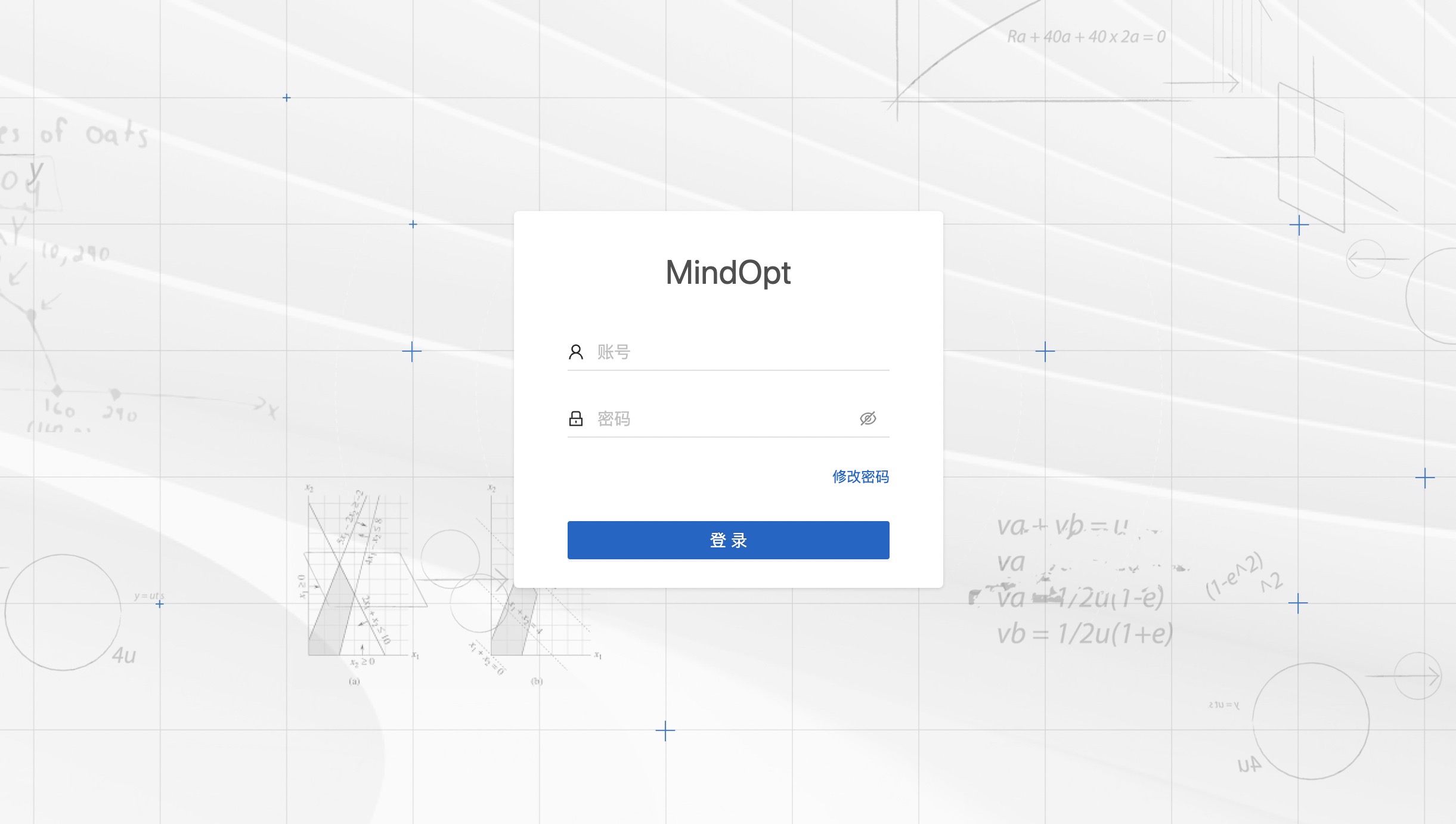
输入账号密码:
默认账号:admin
默认密码:admin
登录后会显示概览欢迎页面:
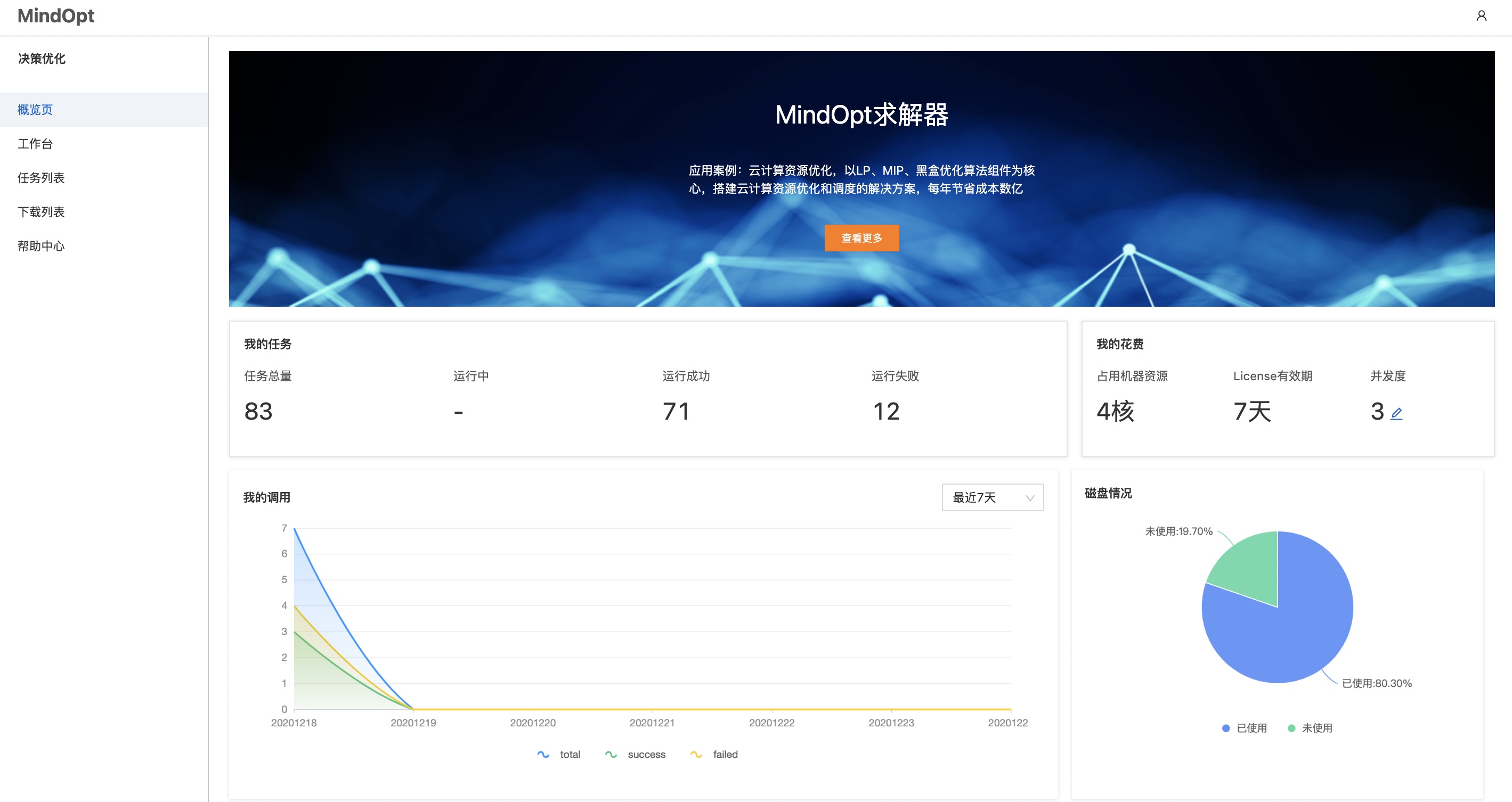
7.9.2. 工作台¶
文件夹 Token 使用
文件夹的作用是方便用户管理不同来源的问题。在使用 Client SDK 提交问题时,相同的 Token 的作业数据将会被记录在同一个文件夹,方便后续的查看、管理和下载数据。
Token的使用方式,以Python为例:
model.set_str_param("Remote/Token", "xxxxxxxxxtokenxxxxxxxx")
您可以通过新建文件夹的方式管理任务放置结构。选中文件夹目录节点,将在该目录下创建子文件夹。
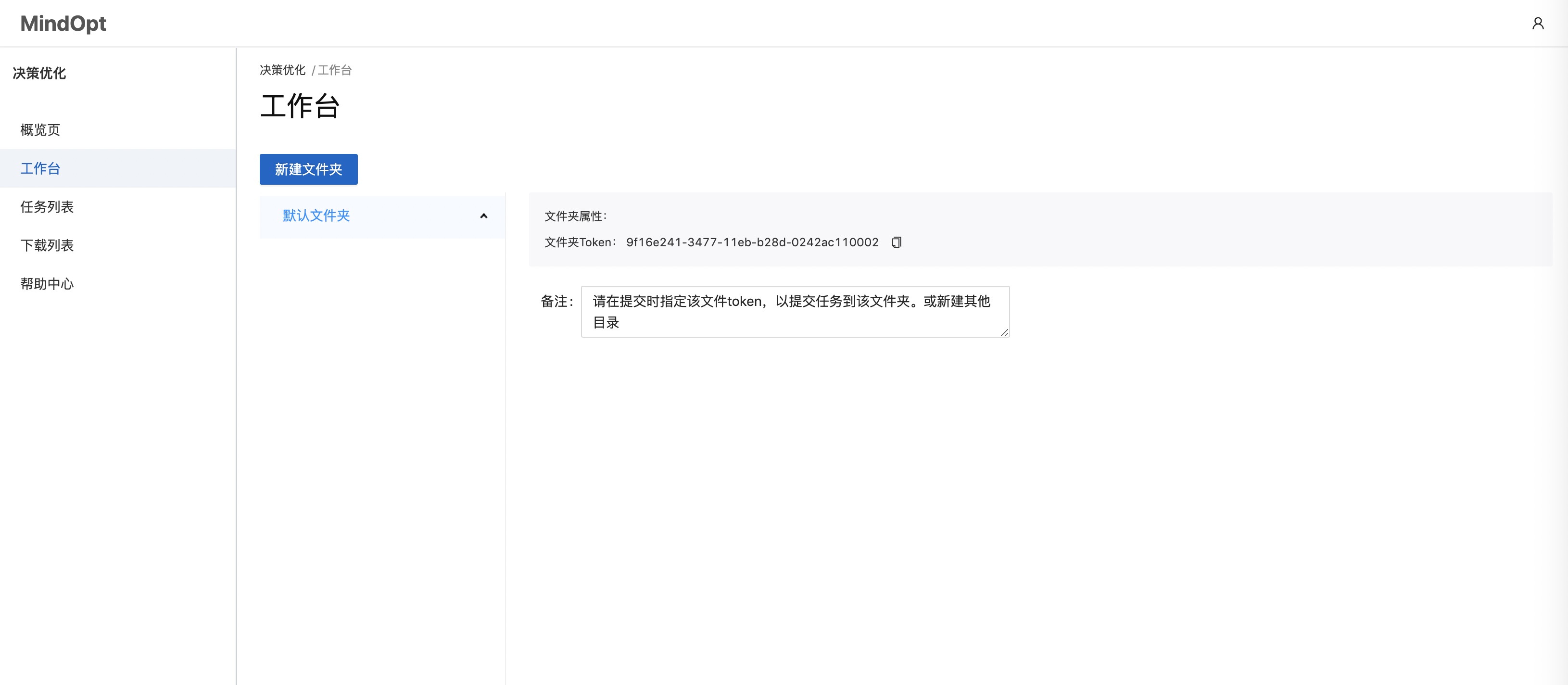
其他功能
后续我们将在此模块上线其他的提交任务的体验方式,尽请期待。
7.9.3. 任务列表¶
计算服务器接收到的所有的任务都会在此展示,当数据存储占用磁盘空间时可按需清理。任务列表提供了全列表视图和文件夹视图。对每一个任务,用户都可以单独查看日志log、数据统计、下载模型、结果、日志数据等。在文件夹视图下,用户可以看到该文件夹下面的所有任务的统计,或者对整个文件夹打包下载。
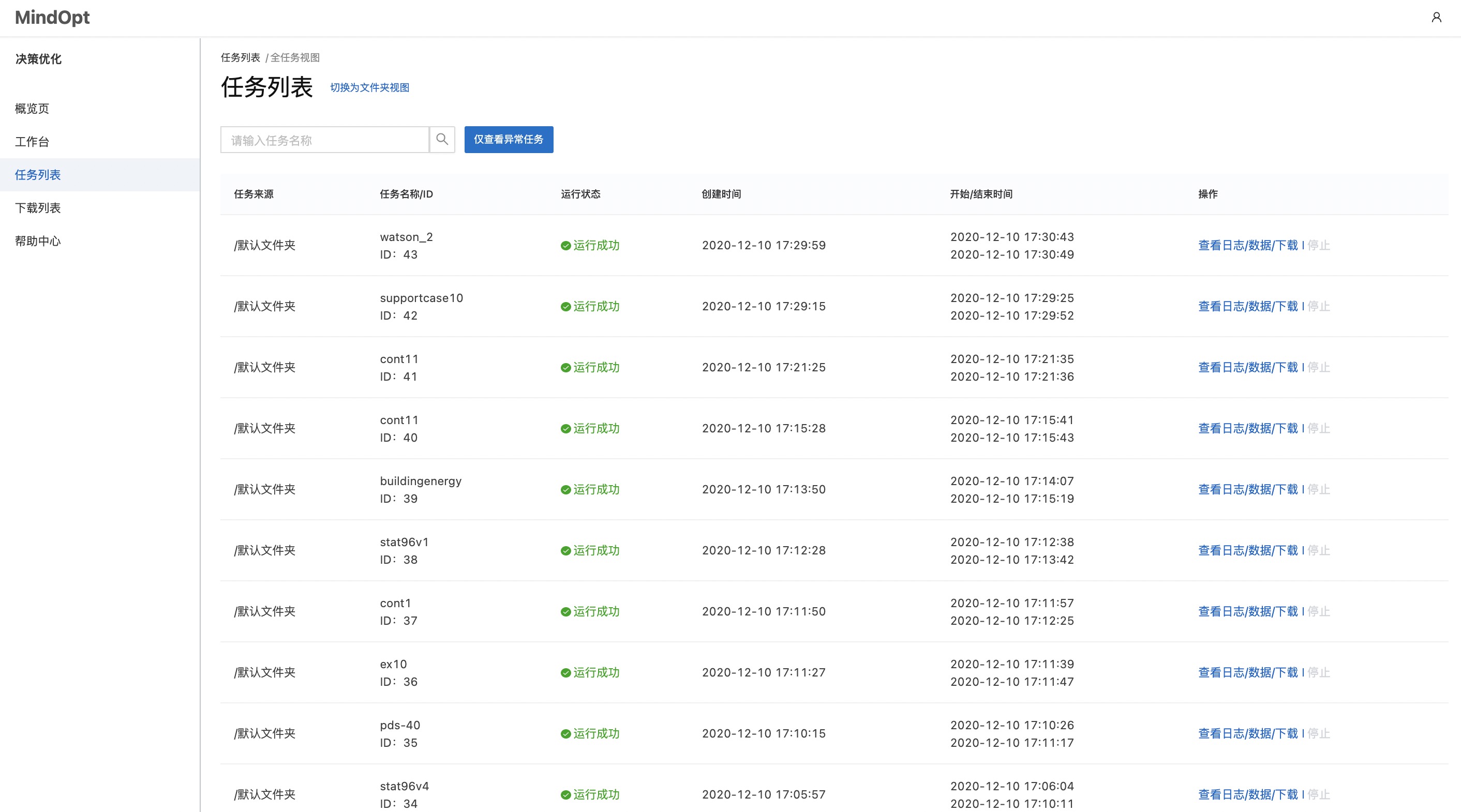
7.9.4. 下载列表¶
本列表记录的是在任务列表中进行如下的”创建下载任务“操作后的作业列表。
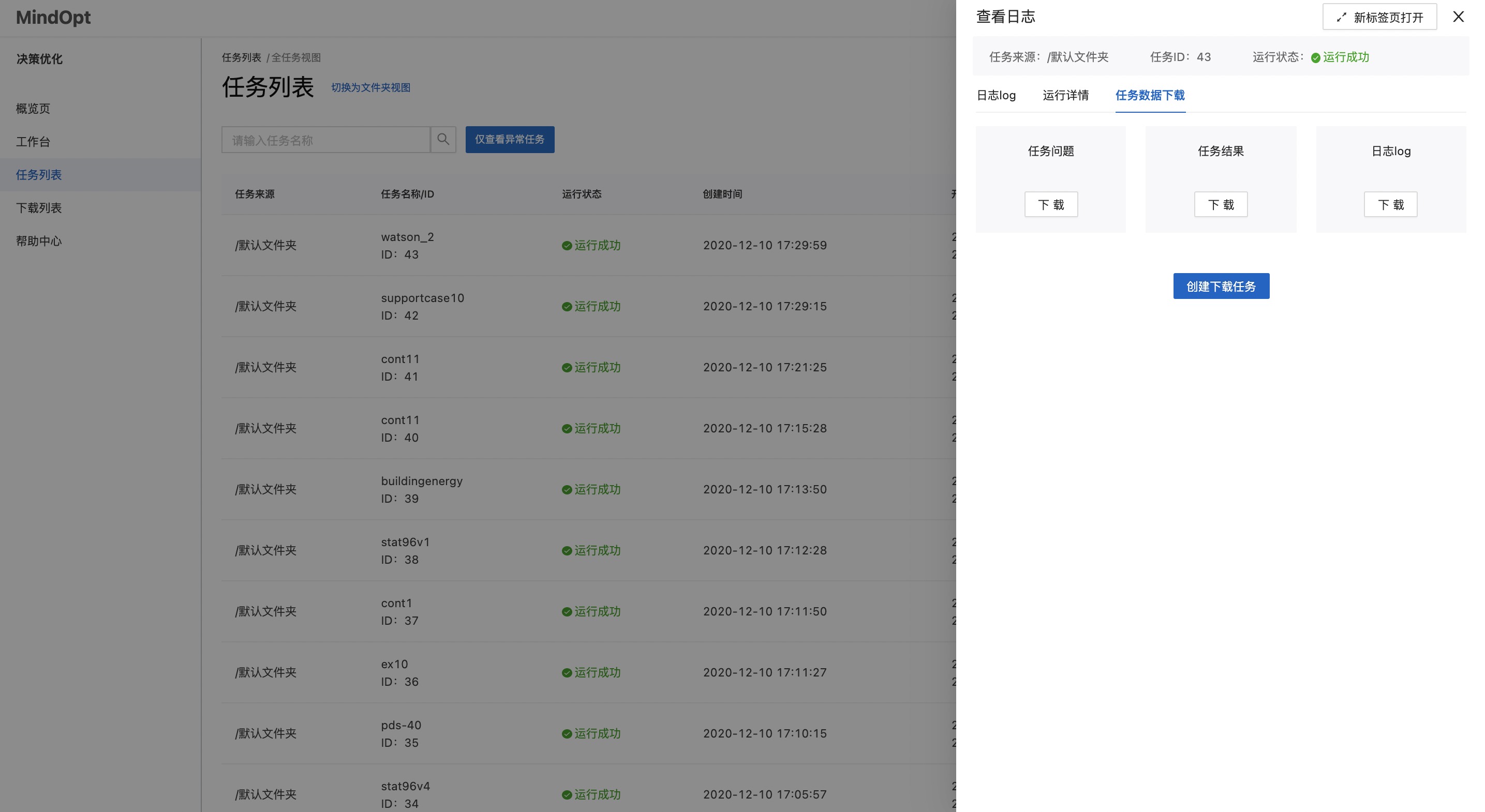
对于数据量大的下载,我们建议您采用”创建下载任务“的方式来下载数据,这样可以在后台打包数据,打包结束之后您可以在下载列表页进行快速下载。
